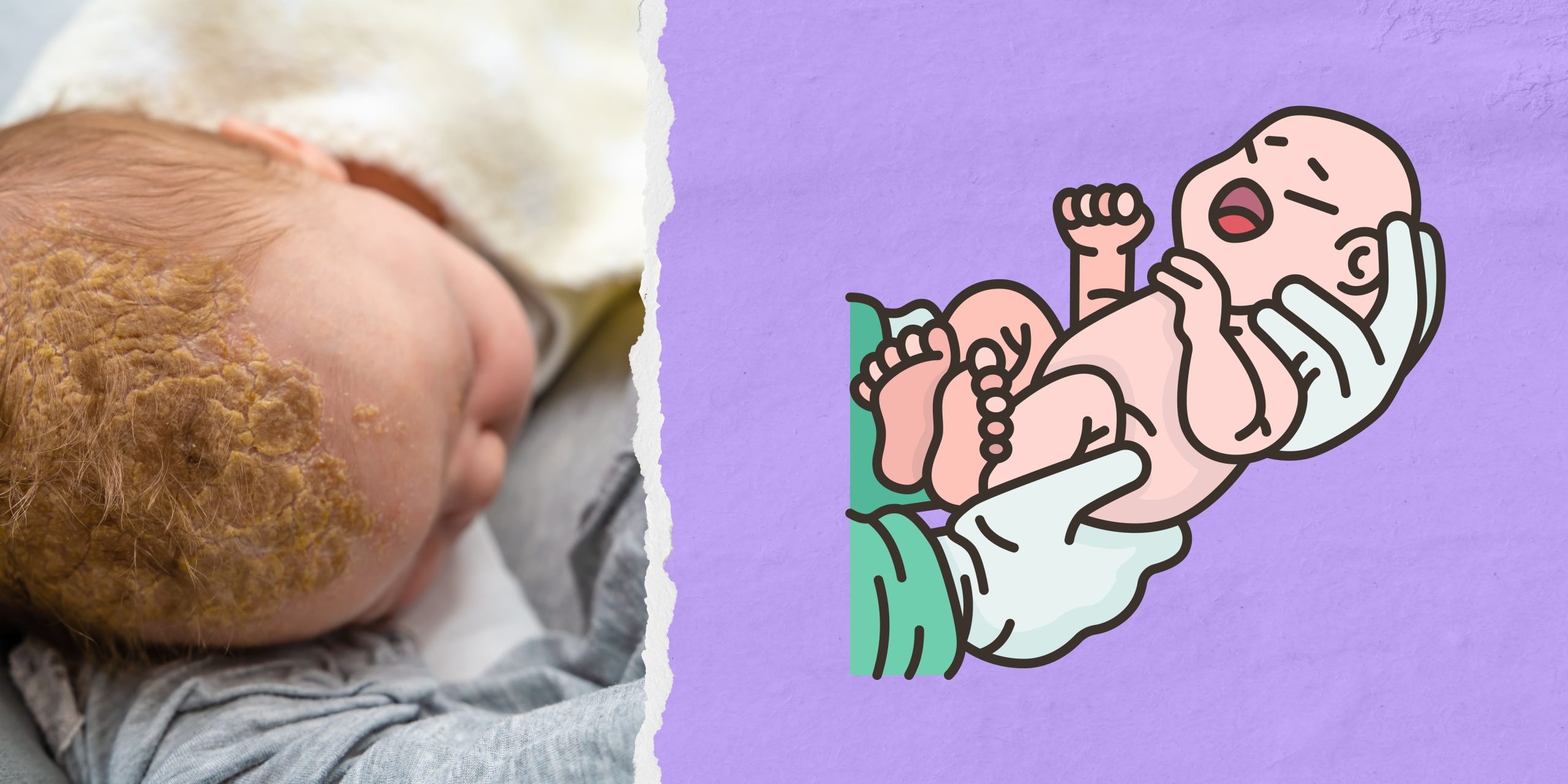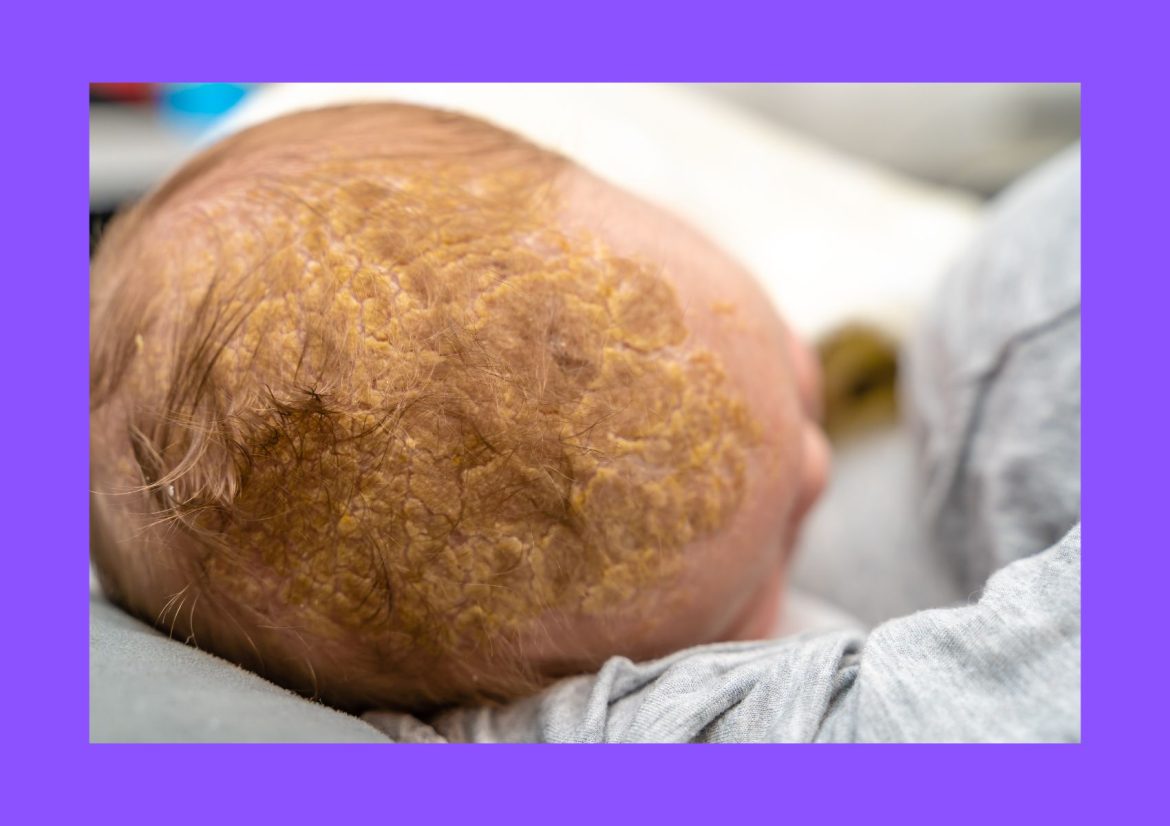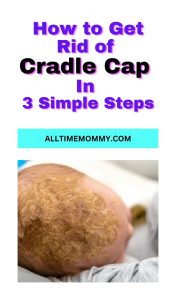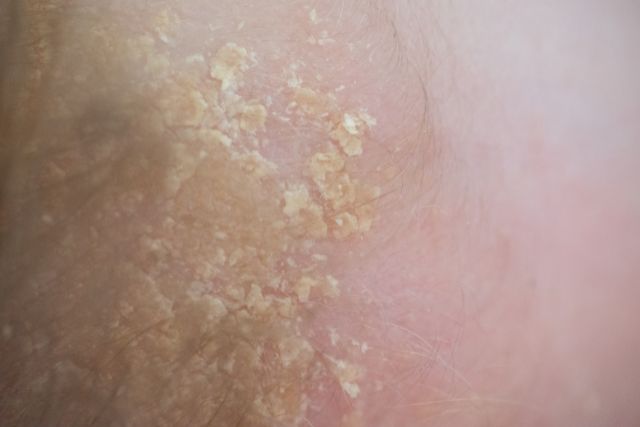Get rid of cradle cap in 3 simple steps! Learn the basics of how to get rid of cradle cap naturally.
Do you have a newborn baby at home with a mysterious, scaly crust on its head?
If so, they may have a cradle cap.
According to The Mayo Clinic cradle cap is a worrisome thick white or yellow scales on your baby’s scalp. Fortunately, it’s not severe and can be treated more quickly than you think!
This blog will provide you with the essential information you need to know about cradle caps.
And not just that.
You will also get the tips you must follow to get rid of cradle cap naturally so that you can set your little one free from this bothersome condition.
But before then, let’s have an overview cradle caps in babies.
Affiliate Disclosure: As an Amazon Associate, I get a small commission for purchases made from Amazon.com through links in this post. Learn more about our affiliate disclaimer here.
What is Cradle Cap?

how to get rid of cradle cap fast
Cradle cap, or crusta lacteal or infantile seborrhoeic dermatitis, are scaly greasy rashes or patches that appear white or yellowish on baby skin.
Sometimes they look like greasy patches of dandruff.
Cradle cap mostly appear on the baby’s head but can extend to the face and behind the eyes.
But you may wander;
What Causes Cradle Cap? Why Do Babies Get Cradle Cap?
According to medics, you may notice greasy, yellowish patches or rashes distributed on areas rich in sebaceous glands.
These areas include the scalp, the external ear, the center of the face, and the intertriginous areas.
NOT Much has been discovered about the causes of cradle cap. However, medics suggest cradle cap may result from overactive sebaceous glands, a fungal infection, or both.
Overactive sebaceous glands
Overactive sebaceous glands occur when the transplacental transfer of maternal androgens stimulates the growth of the infant’s sebaceous glands.
Yes.
The mother’s hormones may stay in the baby’s body for several months after birth.
These maternal hormones may stimulate too much sebum production, and this could prevent the old skin cells from drying and falling off the scalp. Instead, they stick to the scalp, forming the greasy scales.
Fungal Overgrowth
Another cause of cradle cap may be a yeast (fungus) called malassezia.
According to the Mayo Clinic, these fungi do not cause any issues and grow in the sebum with bacteria.
However, sometimes the sweat glands may go out of balance and secrete more oils. If this happens, these fungi can grow out of proportion and cause inflammation and skin irritation.
Additionally, a fungal infection could result from the mother taking antibiotics before giving birth which disrupted the normal gut microbial composition.
How Can I Diagnose Cradle Cap?
Most babies develop a cradle cap between 1 to 3 months and may extend until the infant is about two years.
The first and obvious indication of cradle cap in babies are whitish rash or scaly patches on the skin
Additionally, you may notice the following;
- Dandruff-like flakes of skin on the scalp
- Crusty yellow areas on the scalp
- Areas of the scalp that are like scales
Cradle caps are neither itchy nor painful. They may start on the baby’s scalp but again spread to the area behind other body parts like ears, eyelids, groin, armpits, and backs of the knees.
How Can I Treat Cradle Cap?
According to the American Academy of Dermatologists, a Cradle cap usually doesn’t require medical treatment. It’s a skin condition that goes away on its own.
The American Family Physician also advocates waiting a little longer before taking drastic measures, especially if you’re dealing with mild cradle cap.
According to the AFP, babies’ skins undergo many changes as they mature, eventually resolving by themselves.
In the meantime;
- Wash your baby’s hair more frequently to help soften the scale
- Use fragrance-free and baby-friendly shampoo to avoid causing more skin irritation.
- Gently massage away the scale when shampooing
- If the scaling is heavy, applying natural oil on the scalp for a couple of hours before shampooing. Doing so may help reduce the severity of the cradle cap.
- Know when to seek a professional help
In some cases, pediatricians or dermatologists may recommend anti-fungal and steroid creams like ( 1% Hydrocortisone cream) to be applied topically to combat stubborn cradle caps.
But before you get ready to fight this war with over-the-counter creams and medications, try these natural remedies.
Related;
- Bath Time Made Easy: How To Create a Calm and Stress Free Bath Time for Your Newborn
- Newborn Bath: The Ultimate Guide On How to Safely Bath a Newborn
Is There a Way You Can Get Rid of Cradle Cap?
As a mom, I tried several products for cradle cap and these is what worked best.
How to Get rid of Cradle Cap In 3 Simple Steps
The best home remedy for cradle cap that has stood the test of time involves three simple steps;
Step :1 – hydrate the scalp with plant oil
Hydrating your newborn’s scalp is an excellent way of loosening flakes. You’ll need pure plant oil, like virgin olive, virgin coconut, almond or organic jojoba oil.
To use this method:
- Apply a thin layer of plant oil to your baby’s scalp.
- Gently massage the oil in the scalp. If your infant still has a soft spot take extra caution to avoid hurting the delicate area.
- Let the oil soak in the scalp for about 60 minutes.
- Wash the oil out with gentle baby shampoo.
Some parents prefer overnight oiling and washing in the morning. The key is to ensure the scalp is thoroughly moist and soft before using the brush.
Also plant oil like virgin coconut oil are rich in antibacterial and antifungal properties. allowing these oil to rest on your baby’s skin for sometimes can be beneficial.
If you don’t want to leave the oil overnight, make it a part of your morning routine. Oil your baby’s scalp and let it sit and soak for about an hour.
Step :2 – Garlic & Onion Infused Oil
If your baby’s cradle cap is more severe or you suspect it’s a mild fungal infection, you may want to try a natural antibacterial before going for the over-the-counter creams.
Also, if you have suffered a severe yeast infection, especially in your final trimester, you should check with your doctor if your baby’s cradle cap is due to yeast infection.
So
Why use garlic and onion-infused oil?
According to a study, garlic and onion’s antibacterial properties are effective against the fungi strain Malassezia. Remember, Malassezia is one of fungal strains that can cause cradle cap in babies.
Try this infused natural oil with garlic and onion method for cradle cap:
- Crush 3-4 cloves of garlic and about a ¼ red onion in a motor
- Put your garlic/onion mixture in 3 tablespoons of lukewarm plant oil. I prefer organic coconut oil for this course.
- Allow the mixture to steep and stay overnight in a container.
- Strain the oil from the mixture using a muslin cloth.
- Apply the oil over the baby’s cradle cap and allow it to rest for about 60 minutes.
- Then follow through with washing the head.
- You may repeat the process twice a week.
Step :3 – Brush and Shampoo Your Baby’s Scalp
Gently brushing your newborn’s scalp is an excellent way of removing some flakes off their head.
Be sure only to use special brushes like these for the cradle cap to avoid hurting your baby’s delicate hair.
If you’re a specialist mama, a new toothbrush with gentle bristles also works.
To use this method:
- Brush your baby’s hair in one direction, preferably backwards (away from the forehead); slowly brush the affected area of the scalp to loosen flakes. Be sure to avoid plucking the hair.
Wash with mild baby shampoo twice or thrice a week. Also, wash your newborn sparingly, as over doing so may increase the chances of your baby having dry skin.
- 7 Best Cradle Cap Shampoo For Infants 2023
- Learn How you Can use a Cradle Cap Brush to Manage the Flakes
- 7 Best Cradle Cap Oil For Babies
How Can I Prevent Cradle Cap?
According to medics, Cradle cap is not harmful and eventually clears up. Also, studies suggesting its cause are limited. Due to these reasons, it’s challenging to point out any preventive measures for cradle caps.
However, if you experience a yeast infection during pregnancy, treat it as soon as possible to lower the risk of transferring the effect to your baby during delivery.
What Should You Not Do With a Cradle Cap?
Some parents think bathing a baby more often will help remove the cradle cap.
This is not true since cradle caps in not caused by hygiene issues; it’s useless to subject your newborn to many bath times.
Bathing your newborn too frequently may dry out their skin. This will only trigger their sebaceous glands to release excess oil, delaying cradle cap healing.
Also,
Be patient.
Some parents want the cradle cap to disappear in a few days. Remember that the cradle cap manifests an imbalance inside your baby’s body. You can treat the symptoms (the flaky skin), but it may take a while for the condition to disappear completely.
Check your diet
According to mayo Clinic, yeast may also contribute to cradle cap. Because yeast occurs due to imbalances in your gut flora, as a breastfeeding mom, it would be best if you took a diet that enriches your gut bacteria.
Why?
Because this is the best way to improve your newborn’s gut health through breastfeeding, which may lessen the severity of the cradle cap.
Let’s do the inside-out job!
Eat fermented food like;
- Saukarkeet
- Kefir
- Kombucha
- Greek yoghurt
- Probiotic Supplement.
Related: 7 Simple Diet Tips To Fight Recurring Candida Yeast Infection
Eat food Rich in Biotin
Biotin deficiency may also cause cradle caps in infants. As a woman who has been through pregnancy and subsequent breastfeeding, it’s possible to have a biotin deficiency.
Include foods rich in this vitamin in your diet.
This will help build up the supply for your breastfeeding infant too. Here are some of the foods that are rich in Biotin:
- Eggs
- Salmon
- Avocado
- Cauliflower
- beef
Common Questions About Cradle Cap in Babies
Do all babies get cradle cap?
Although cradle cap is very common, not all babies get cradle cap. According to the (AAFP), about 10 % of baby boys and 9.5 per cent of baby girls have it. But do not be surprised if your newborn goes through the stages of development without testing the cradle cap menace. Its still normal mama!
Does cradle cap itch?
No. Cradle cap is nether itchy, uncomfortable for baby nor contagious. Its just a batch of dead skins trying to find their way out.
However if you notice some blisters that may seem uncomfortable for your little one, be sure to contact your professional health care provider. These may denote some other infections that need medical attention.
Do cradle cap smell?
Under normal circumstances, cradle cap do not smell. However, if your baby is dealing with a severe case of cradle cap, it’s normal to detect a slight oily scent. This is due to the buildup of oil or sebum from sebaceous glands on your baby’s scalp.
Also, if you’re smelling some weird odor, establish whether it’s vernix caseosa.
The vernix caseosa is the peeling–like glue coat that helps your baby’s skin adapt to life outside the womb. This coat is normally washed off about 24 hours after birth, but the scent may still linger on the newborn’s hair and skin for a while.
Do cradle caps cause hair loss?
Cradle caps do not cause hair loss. However, roughly rubbing when picking the scales from your baby’s head could damage the delicate hair follicle. If the damage occurs below the skin’s surface, it may not be visible but painful for the infant.
Does breast milk help cradle cap?
According to a study, Breastmilk contains various protective components like lysozyme immunoglobulins, lactoferrin, and immune cell subsets. Infact, this study found Breastmilk to be an effective eye drop in infants with eye discharge.
If this is so, why not try it on the cradle cap?
Even though limited studies directly link BM to cradle cap, many parents have found breast milk to be an effective cradle cap treatment.
Add a small amount of breast milk to your baby’s shampoo or plant oil, and gently massage the scalp with the mixture. Leave the milk combo on the scalp for a while before shampooing it off.
How do I know if my baby’s cradle cap is infected?
Seek immediate medical help if;
- The cradle cap starts to ooze fluid like substances
- The cradle cap has wired smell
- the area becomes red
- instinctively you feel like taking your baby to a dermatologist for a professional advice.
Take away
Cradle cap is a common and harmless condition in newborns and young babies, but that doesn’t mean you must live with it. You can manage the cradle cap for good with a few simple steps. Don’t hesitate to contact a medical professional if you’re overwhelmed – they’re here to help you give your baby the best care possible.
Please Share this post with other parents or caregivers of young children who may be experiencing cradle cap.
UPNEXT:
- 15 Scary Newborn Experiences You May Encounter In The First Six Months After Birth
- 9 Best Baby Soap and Shampoos According to Dermatologist
- The Umbilical Cord Care: Simple Daily Practices To Ensure Your Baby’s Umbilical Cord Heals Faster
- Here are 10 Super Effective Remedies of Colic in Babies
- Is Your Baby Constipating? This is What You Need To Know About Relieving Constipation In Infants
DISCLAIMER The information contained in this post is for general information purposes only. I’m not a health practitioner and as such, this information should not be used as a substitute for consultation with your professional service provider.



